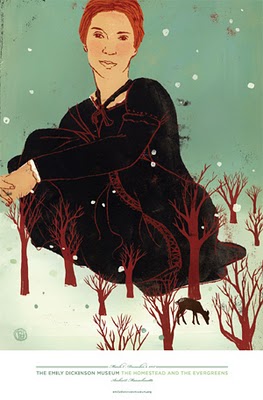
 Emily Dickinson is a tough sell for high school kids. I remember, junior year, counting the days until the “poetry section” of American Lit was over. Red wheelbarrows and blades of grass were all well and good, but I craved something linear, something I could wrap my adolescent mind around a bit more easily, maybe a witch trial or a steamboat or a red badge of courage. And if I had to write a paper about a poem, certainly the shorter the better, and no one wrote shorter poems than Emily Dickinson. But then I started reading and it was all so inscrutable. Flowers and bees, hope and feathers – I had no idea what she was on about. So I filed her under “acquired taste” (AKA intimidating/girly) and moved on.
Emily Dickinson is a tough sell for high school kids. I remember, junior year, counting the days until the “poetry section” of American Lit was over. Red wheelbarrows and blades of grass were all well and good, but I craved something linear, something I could wrap my adolescent mind around a bit more easily, maybe a witch trial or a steamboat or a red badge of courage. And if I had to write a paper about a poem, certainly the shorter the better, and no one wrote shorter poems than Emily Dickinson. But then I started reading and it was all so inscrutable. Flowers and bees, hope and feathers – I had no idea what she was on about. So I filed her under “acquired taste” (AKA intimidating/girly) and moved on.
Years later, Dr. Dorothy Martyn re-introduced me to Emily, or you might say, properly introduced me to “the poet” herself, and I could not be more grateful that she did. Dr. Martyn had just written a phenomenal book about child psychology entitled Beyond Deserving (best title ever?), the basis for which was Dickinson’s Poem #1058. In Dr. Martyn’s capable hands, the layers of Dickinson’s botanical imagery came alive. It was an eye-opening experience, not just about Dickinson but poetry in general. Dr. Martyn would refer to Dickinson, both in writing and in speech, with a reverence and affection that most people reserve for Scripture. And what beautiful words they were! A few of the priceless lines that she dropped on me came from Emily’s letters. For example:
“The etiquette of the admonition is questionable – though of it’s imperativeness there is no doubt.” – Letter 502
“How few suggestions germinate!” – Letter 888
“Dear arrears of tenderness we can never repay till the will’s great ores are finally sifted” – Letter 889
But Emily’s poetry, of course, is where the greatest treasures lie. It is there that one encounters her undeniably prophetic insight into the nature of reality (and therefore, God), a view of life which took full account of human suffering and subconscious radioactivity/inertia, yet understood the concurrent beauty of grace and mercy and inspiration. She could express the chill of death and loneliness one moment, the warmth of friendship and love the next, sometimes in a single line. The cruxiformity on display is frequently staggering – her work is God-haunted to the core – while thankfully resistant to most/all religious labels. In other words, Dickinson’s extraordinary wisdom, like her language, transcends our attempts to categorize or co-opt it.
Over the past few years, I’ve tried to make a record of some of her most relevant work on this site. Or at least my favorites. Her poems are best ingested in small doses, but in case you find that you lack the fortitude/interest today, a few particularly potent examples include:
Poem 688
 “Speech” – is a prank of Parliament –
“Speech” – is a prank of Parliament –
“Tears” – is a trick of the nerve –
But the Heart with the heaviest freight on –
Doesn’t – always – move –
Poem 816
A Death blow is a Life blow to Some
Who till they died, did not alive become–
Who had they lived, had died but when
They died, Vitality begun.
Poem 1225
Its Hour with itself
The Spirit never shows.
What Terror would enthrall the Street
Could Countenance disclose
The Subterranean Freight
The Cellars of the Soul—
Thank God the loudest Place he made
Is license to be still.
Poem 1355
The Mind lives on the Heart
Like any Parasite –
If that is full of Meat
The Mind is fat.
But if the Heart omit
Emaciate the Wit –
The Aliment of it
So absolute.
Her Losses make our Gains ashamed —
She bore Life’s empty Pack
As gallantly as if the East
Were swinging at her Back.
Life’s empty Pack is heaviest,
As every Porter knows —
In vain to punish Honey —
It only sweeter grows.
Poem 1656
Down Time’s quaint stream
Without an oar
We are enforced to sail
Our Port a secret
Our Perchance a Gale
What Skipper would
Incur the Risk
What Buccaneer would ride
Without a surety from the Wind
Or schedule of the Tide —
P.S. If you’re looking to explore Dickinson’s work, I would pass on the suggestion that Dr. Martyn gave me. Start with Richard Sewall’s excellent biography and go from there.

COMMENTS
Leave a Reply













